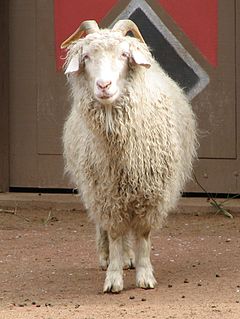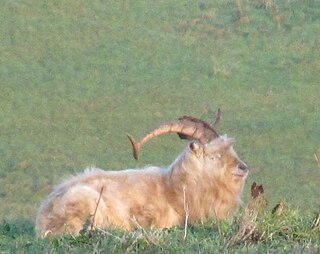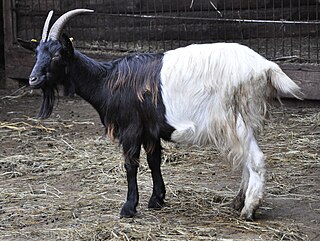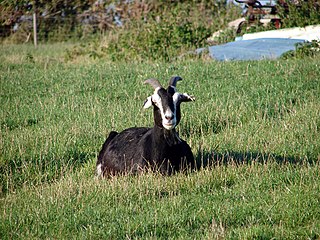
The Tauernscheck goat breed from Austria is used for the production of milk. It is a very rare breed derived from the Austrian Landrace and Pinzgauer goat breeds.

The Tauernscheck goat breed from Austria is used for the production of milk. It is a very rare breed derived from the Austrian Landrace and Pinzgauer goat breeds.

The Angora or Ankara is a Turkish breed of domesticated goat. It produces the lustrous fibre known as mohair. It is widespread in many countries of the world. Many breeds derive from it, among them the Indian Mohair, the Soviet Mohair, the Angora-Don of the Russian Federation and the Pygora in the United States.

The Boer or Boerbok is a South African breed of meat goat. It was selectively bred in the Eastern Cape from about 1920 for meat qualities and for the ability to survive by grazing on the thorn veldt of that region. It has been exported to many countries, and has been used to improve the meat qualities of other breeds.

The American Pygmy is an American breed of achondroplastic goat. It is small, compact and stockily built. Like the Nigerian Dwarf, it derives from the West African Dwarf group of breeds of West Africa. Between 1930 and 1960, animals of this type were imported to the United States for use either as zoo animals or for research; some were later kept and bred as companion animals and established as a breed in 1975. It may also be known as the Pygmy or African Pygmy. It is quite different and separate from the British Pygmy breed.

The Nigerian Dwarf is an American breed of dwarf goat. Like the American Pygmy Goat, it derives from the West African Dwarf group of breeds of West Africa.

The myotonic goat or Tennessee fainting goat is an American breed of goat. It is characterised by myotonia congenita, a hereditary condition that may cause it to stiffen or fall over when excited or startled. It may also be known as the fainting goat, falling goat, stiff-legged goat or nervous goat, or as the Tennessee wooden-leg goat. Four goats of this type were brought to Tennessee in the 1880s.

The Bagot goat is a breed of goat which for several hundred years has lived semi-wild at Blithfield Hall, Staffordshire, England.

A cashmere goat is a type of goat that produces cashmere wool, the goat's fine, soft, downy, winter undercoat, in commercial quality and quantity. This undercoat grows as the day length shortens and is associated with an outer coat of coarse hair, which is present all the year and is called guard hair. Most common goat breeds, including dairy goats, grow this two-coated fleece.

The Bilberry goat is a breed of feral goat which is believed to have lived in one herd on Bilberry Rock in Waterford City in the south of Ireland for hundreds of years.

The Anglo-Nubian is a British breed of domestic goat. It originated in the nineteenth century from cross-breeding between native British goats and a mixed population of large lop-eared goats imported from India, the Middle East and North Africa. It is characterised by large, pendulous ears and a convex profile. It has been exported to many parts of the world, and is found in more than sixty countries. In many of them it is known simply as the Nubian.

The Golden Guernsey is a rare breed of dairy goat from Guernsey in the Channel Islands, where it has been known for more than two hundred years.

The goat or domestic goat is a domesticated species of goat-antelope typically kept as livestock. It was domesticated from the wild goat of Southwest Asia and Eastern Europe. The goat is a member of the animal family Bovidae and the tribe Caprini, meaning it is closely related to the sheep. There are over 300 distinct breeds of goat. It is one of the oldest domesticated species of animal, according to archaeological evidence that its earliest domestication occurred in Iran at 10,000 calibrated calendar years ago.

The Irish Goat is a traditional Irish breed of domestic goat. It is a dual-purpose breed, used both for meat and for milk. It is an endangered breed and may survive only in feral populations. It is distinct from the feral Bilberry Goat of Waterford.

The Valais Blackneck is a breed of domestic goat from the canton of Valais, in southern Switzerland, and neighbouring areas of northern Italy. The largest concentration is in the area of Visp (Viège). It is present in modest numbers in Austria and Germany. It is known by many names, including German: Walliser Schwarzhalsziege or Gletschergeiss; French: Col Noir du Valais, Chèvre des Glaciers or Race de Viège; and Italian: Vallesana or Vallese.

The British Alpine goat is a breed of domestic goat developed in the early 1900s. A standard British Alpine goat is black all over with white 'Swiss' markings. Another well-known breed that has these markings is the Toggenburg goat, and the breed was developed from the Toggenburg, native British goats, and Nubian genetics. The British Alpine is a high producer of quality goats' milk, and the breed can be found in many goat dairies as an acceptable milker. These goats are capable of extended lactations, sometimes even lasting close to two years.

The British primitive goat is a landrace of domestic goat native to Great Britain and Ireland, and is the original goat of the region. It is considered a rare breed, existing as several, isolated feral herds, as some captive populations in zoological parks and nature reserves, and breeding stock on some private farms operated by groups of rare-breed enthusiasts. As few as 1,200 individual British primitives may remain. The variety is also referred to as the British native goat, the old British goat, the old English goat or the British landrace goat, among more specific names It descends from the earliest goats brought to the region in the Neolithic era, around 3,000 BCE. It is classified in the Northern breed group of goats. A population in Northumbria is sometimes referred to as the Cheviot goat. The British primitive is among the foundation stock of some modern standardised breeds, including the Anglo-Nubian goat. The breed is comparatively small, with commensurately low milk production. It is hardy and wiry haired, adapted to rough terrain and weather, and able to subsist and breed on its own without human intervention.
The Passeirer Gebirgsziege or Capra Passiria is an indigenous breed of domestic goat from the Passeier valley or Val Passiria, in the Autonomous Province of Bolzano in north-eastern Italy. It is raised in that valley and in the neighbouring Sarntal, Schnalstal and upper Wipptal valleys; it is also present in neighbouring areas of southern Austria. While of Alpine type, it is morphologically quite distinct from the Alpina Comune goat breed. Management is extensive: the animals are kept on alpine pasture from early spring to late autumn.

The Chamois Coloured Goat, French: Chèvre chamoisée, German: Gämsfarbige Gebirgsziege, Italian: Camosciata delle Alpi, is an indigenous breed of domestic goat from Switzerland. It is distributed throughout Switzerland and in parts of northern Italy and Austria, and has been exported to other countries including France. There are two strains, a horned type from the Grisons or Graubünden in the eastern part of the country, and a hornless type from the former bezirk of Oberhasli and the area of Brienz and Lake Brienz in the Bernese Oberland in central Switzerland. In some countries the hornless variety may be considered a separate breed, the Oberhasli goat. The Swiss herd-book was established in 1930.

Polycerates are animals with more than two horns.

The Pygmy is a British breed of dwarf goat. It is small, compact and generally stockily built. It was established in the 1980s by fusion of the various miniature goat populations of the United Kingdom into a single breed. These were of two principal types: a stocky achondroplastic type derived from the West African Dwarf group of breeds of West Africa; and a small but well-proportioned type derived from the Southern Sudan goat.